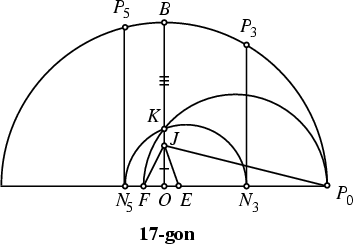|
|
|

The Regular Polygon of 17 sides is called the Heptadecagon, or sometimes the Heptakaidecagon.
Gauß ![]() proved in 1796 (when he was 19 years old) that the heptadecagon is Constructible with a Compass and Straightedge. Gauss's proof appears in his monumental work Disquisitiones
Arithmeticae. The proof relies on the property of irreducible Polynomial equations that Roots
composed of a finite number of Square Root extractions only exist when the order of the equation
is a product of the form
proved in 1796 (when he was 19 years old) that the heptadecagon is Constructible with a Compass and Straightedge. Gauss's proof appears in his monumental work Disquisitiones
Arithmeticae. The proof relies on the property of irreducible Polynomial equations that Roots
composed of a finite number of Square Root extractions only exist when the order of the equation
is a product of the form
![]() , where the
, where the ![]() are distinct Primes of the form
are distinct Primes of the form

The following elegant construction for the heptadecagon (Yates 1949, Coxeter 1969, Stewart 1977, Wells 1992) was first given by Richmond (1893).
This construction, when suitably streamlined, has Simplicity 53. The construction of Smith (1920) has a greater
Simplicity of 58. Another construction due to Tietze (1965) and reproduced in Hall (1970) has a Simplicity of
50. However, neither Tietze (1965) nor Hall (1970) provides a proof that this construction is correct. Both Richmond's and
Tietze's constructions require extensive calculations to prove their validity. De Temple (1991) gives an elegant construction
involving the Carlyle Circles which has Geometrography symbol
![]() and
Simplicity 45. The construction problem has now been automated to some extent (Bishop 1978).
and
Simplicity 45. The construction problem has now been automated to some extent (Bishop 1978).
See also 257-gon, 65537-gon, Compass, Constructible Polygon, Fermat Number, Fermat Prime, Regular Polygon, Straightedge, Trigonometry Values Pi/17
References
Archibald, R. C. ``The History of the Construction of the Regular Polygon of Seventeen Sides.''
Bull. Amer. Math. Soc. 22, 239-246, 1916.
Archibald, R. C. ``Gauss and the Regular Polygon of Seventeen Sides.'' Amer. Math. Monthly 27,
323-326, 1920.
Ball, W. W. R. and Coxeter, H. S. M. Mathematical Recreations and Essays, 13th ed. New York: Dover, pp. 95-96, 1987.
Bishop, W. ``How to Construct a Regular Polygon.'' Amer. Math. Monthly 85, 186-188, 1978.
Conway, J. H. and Guy, R. K. The Book of Numbers. New York: Springer-Verlag, pp. 201 and 229-230, 1996.
Coxeter, H. S. M. Introduction to Geometry, 2nd ed. New York: Wiley, pp. 26-28, 1969.
De Temple, D. W. ``Carlyle Circles and the Lemoine Simplicity of Polygonal Constructions.'' Amer. Math. Monthly
98, 97-108, 1991.
Dixon, R. ``Gauss Extends Euclid.'' §1.4 in Mathographics. New York: Dover, pp. 52-54, 1991.
Gauss, C. F. §365 and 366 in Disquisitiones Arithmeticae.
Leipzig, Germany, 1801. New Haven, CT: Yale University Press, 1965.
Hall, T. Carl Friedrich Gauss: A Biography. Cambridge, MA: MIT Press, 1970.
Klein, F. Famous Problems of Elementary Geometry and Other Monographs. New York: Chelsea, 1956.
Ore, Ø. Number Theory and Its History. New York: Dover, 1988.
Rademacher, H. Lectures on Elementary Number Theory. New York: Blaisdell, 1964.
Richmond, H. W. ``A Construction for a Regular Polygon of Seventeen Sides.'' Quart. J. Pure Appl. Math. 26, 206-207, 1893.
Smith, L. L. ``A Construction of the Regular Polygon of Seventeen Sides.'' Amer. Math. Monthly 27, 322-323, 1920.
Stewart, I. ``Gauss.'' Sci. Amer. 237, 122-131, 1977.
Tietze, H. Famous Problems of Mathematics. New York: Graylock Press, 1965.
Wells, D. The Penguin Dictionary of Curious and Interesting Geometry.
New York: Viking Penguin, 1992.
Yates, R. C. Geometrical Tools. St. Louis, MO: Educational Publishers, 1949.
|
|
|
© 1996-9 Eric W. Weisstein